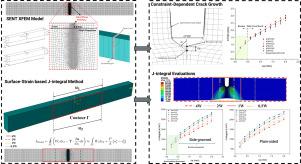Numerical investigation of constraint-dependent crack growth in X70 pipeline steel using XFEM-based cohesive segments approach with surface strain-based J-integral evaluation
IF 5.6
2区 工程技术
Q1 ENGINEERING, MECHANICAL
引用次数: 0
Abstract
This study employs the Extended Finite Element Method-based cohesive segments approach to investigate the constraint-dependent fracture behavior of API X70 pipeline steel. The Single Edge Notched Tension (SENT) geometry is used for numerical analysis within the Abaqus software since it closely replicates the tip constraint of the surface flaws typically observed on steel pipelines. The primary focus is to derive J-integral and Crack Tip Opening Displacement (CTOD) resistance curves for plain-sided and side-grooved specimens with varying initial crack depths. Before post-processing the XFEM models, validation occurred against experimental data. Then, three J-integral calculation methods were systematically compared, including incremental unloading compliance, CTOD conversion, and the surface strain-based XFEM method. Accordingly, a path-independency analysis of the surface strain-based XFEM method, which overcomes limitations for J-integral evaluation during crack growth, was conducted to assess the influence of the plastic zone. Results indicate that side-grooved specimens yield 3%–10% lower CTOD values than plain-sided counterparts due to enhanced crack-tip constraint while reducing variability in resistance curves. Among the J-integral calculation methods, the surface strain-based XFEM approach yielded results similar to standardized methods for crack extensions lower than 1 mm. However, the incremental unloading compliance-based method underestimates J-integral relative to the other two methods beyond 1 mm. It is also found that shallow cracks may exhibit up to 13% higher J-integral values than deep cracks, highlighting the constraint dependence of fracture toughness. This study’s outcomes show the efficacy of XFEM in simulating low-constraint fracture conditions and provide invaluable insights for pipeline integrity assessments.

基于xfem的内聚段法和基于表面应变的j积分法对X70管线钢约束相关裂纹扩展的数值研究
本研究采用基于扩展有限元法的内聚段方法研究API X70管道钢的约束相关断裂行为。单边缘缺口张力(SENT)几何形状用于Abaqus软件中的数值分析,因为它紧密地复制了钢管表面缺陷的尖端约束。主要重点是推导不同初始裂纹深度的平边和边槽试件的j积分和裂纹尖端张开位移(CTOD)阻力曲线。在对XFEM模型进行后处理之前,对实验数据进行验证。然后,系统比较了增量卸载柔度法、CTOD转换法和基于表面应变的XFEM法3种j积分计算方法。因此,采用基于表面应变的XFEM方法进行路径无关分析,以评估塑性区对裂纹扩展的影响,克服了裂纹扩展过程中j积分评估的局限性。结果表明,侧开槽试件的CTOD值比平开槽试件低3% ~ 10%,这是由于侧开槽试件的裂纹尖端约束增强,同时降低了阻力曲线的变异性。在j积分计算方法中,基于表面应变的XFEM方法对于裂纹扩展小于1 mm的结果与标准化方法相似。然而,基于增量卸载柔度的方法相对于其他两种方法低估了j积分超过1mm。研究还发现,浅裂纹的j积分值可能比深裂纹高13%,突出了断裂韧性的约束依赖性。该研究结果显示了XFEM在模拟低约束断裂条件方面的有效性,并为管道完整性评估提供了宝贵的见解。
本文章由计算机程序翻译,如有差异,请以英文原文为准。
求助全文
约1分钟内获得全文
求助全文
来源期刊

Theoretical and Applied Fracture Mechanics
工程技术-工程:机械
CiteScore
8.40
自引率
18.90%
发文量
435
审稿时长
37 days
期刊介绍:
Theoretical and Applied Fracture Mechanics'' aims & scopes have been re-designed to cover both the theoretical, applied, and numerical aspects associated with those cracking related phenomena taking place, at a micro-, meso-, and macroscopic level, in materials/components/structures of any kind.
The journal aims to cover the cracking/mechanical behaviour of materials/components/structures in those situations involving both time-independent and time-dependent system of external forces/moments (such as, for instance, quasi-static, impulsive, impact, blasting, creep, contact, and fatigue loading). Since, under the above circumstances, the mechanical behaviour of cracked materials/components/structures is also affected by the environmental conditions, the journal would consider also those theoretical/experimental research works investigating the effect of external variables such as, for instance, the effect of corrosive environments as well as of high/low-temperature.
 求助内容:
求助内容: 应助结果提醒方式:
应助结果提醒方式:


